Immobilization of Ionic Liquid on a Covalent Organic Framework for Effectively Catalyzing Cycloaddition of CO2 to Epoxides
Abstract
:1. Introduction
2. Experimental
2.1. Materials
2.2. Synthesis of IM4F-Py-COF
2.3. Synthesis of BMIM4F-Py-COF
2.4. General Procedures for Cycloaddition of CO2 with Epoxides
2.5. Characterization
3. Results and Discussion
4. Conclusions
Supplementary Materials
Author Contributions
Funding
Institutional Review Board Statement
Informed Consent Statement
Data Availability Statement
Conflicts of Interest
Sample Availability
References
- Feng, X.; Ding, X.S.; Jiang, D.L. Covalent organic frameworks. Chem. Soc. Rev. 2012, 41, 6010–6022. [Google Scholar] [CrossRef] [PubMed]
- Hu, H.; Yan, Q.Q.; Ge, R.L.; Gao, Y.A. Covalent organic frameworks as heterogeneous catalysts. Chin. J. Catal. 2018, 39, 1167–1179. [Google Scholar] [CrossRef]
- Geng, K.; He, T.; Liu, R.Y.; Dalapati, S.; Tan, K.T.; Li, Z.P.; Tao, S.S.; Gong, Y.F.; Jiang, Q.H.; Jiang, D.L. Covalent organic frameworks: Design, synthesis, and functions. Chem. Rev. 2020, 120, 8814–8933. [Google Scholar] [CrossRef]
- Chen, X.Y.; Geng, K.; Liu, R.Y.; Tan, K.T.; Gong, Y.F.; Li, Z.P.; Tao, S.S.; Jiang, Q.H.; Jiang, D.L. Kovalente organische Gerüstverbindungen: Chemische Ansätze für Designerstrukturen und integrierte Funktionen. Angew. Chem. Int. Ed. 2020, 132, 5086–5129. [Google Scholar] [CrossRef]
- Lin, S.; Diercks, C.S.; Zhang, Y.B.; Kornienko, N.; Nichols, E.M.; Zhao, Y.; Paris, A.R.; Kim, D.; Yang, P.; Yaghi, O.M. Covalent organic frameworks comprising cobalt porphyrins for catalytic CO2 reduction in water. Science 2015, 349, 1208–1213. [Google Scholar] [CrossRef] [PubMed]
- Ding, S.Y.; Gao, J.; Wang, Q.; Zhang, Y.; Song, W.G.; Su, C.Y.; Wang, W. Construction of covalent organic framework for catalysis: Pd/COF-LZU1 in Suzuki-Miyaura coupling reaction. J. Am. Chem. Soc. 2011, 133, 19816–19822. [Google Scholar] [CrossRef]
- Vyas, V.S.; Haase, F.; Stegbauer, L.; Savasci, G.; Podjaski, F.; Ochsenfeld, C.; Lotsch, B.V. A tunable azine covalent organic framework platform for visible light-induced hydrogen generation. Nat. Commun. 2015, 6, 8508. [Google Scholar] [CrossRef]
- Sun, Q.; Aguila, B.; Perman, J.; Nguyen, N.; Ma, S. Flexibility matters: Cooperative active sites in covalent organic framework and threaded ionic polymer. J. Am. Chem. Soc. 2016, 138, 15790–15796. [Google Scholar] [CrossRef]
- Wang, X.; Han, X.; Zhang, J.; Wu, X.; Liu, Y.; Cui, Y. Homochiral 2D porous covalent organic frameworks for heterogeneous asymmetric catalysis. J. Am. Chem. Soc. 2016, 138, 12332–12335. [Google Scholar] [CrossRef]
- Sun, Q.; Tang, Y.; Aguila, B.; Wang, S.; Xiao, F.S.; Thallapally, P.K.; Al-Enizi, A.M.; Nafady, A.; Ma, S. Reaction environment modification in covalent organic frameworks for catalytic performance enhancement. Angew. Chem. Int. Ed. 2019, 58, 8670–8675. [Google Scholar] [CrossRef]
- Bhadra, M.; Kandambeth, S.; Sahoo, M.K.; Addicoat, M.; Balaraman, E.; Banerjee, R. Triazine functionalized porous covalent organic framework for photo-organocatalytic E-Z isomerization of olefins. J. Am. Chem. Soc. 2019, 141, 6152–6156. [Google Scholar] [CrossRef] [PubMed]
- Du, Y.; Yang, H.; Whiteley, J.M.; Wan, S.; Jin, Y.; Lee, S.H.; Zhang, W. Ionic covalent organic frameworks with spiroborate linkage. Angew. Chem. Int. Ed. 2016, 55, 1737–1741. [Google Scholar] [CrossRef] [PubMed]
- Zeng, Y.; Zou, R.; Zhao, Y. Covalent organic frameworks for CO2 capture. Adv. Mater. 2016, 28, 2855–2873. [Google Scholar] [CrossRef]
- Baldwin, L.A.; Crowe, J.W.; Pyles, D.A.; McGrier, P.L. Metalation of a mesoporous three-dimensional covalent organic framework. J. Am. Chem. Soc. 2016, 138, 15134–15137. [Google Scholar] [CrossRef] [PubMed]
- Pramudya, Y.; Mendoza-Cortes, J.L. Design principles for high H2 storage using chelation of abundant transition metals in covalent organic frameworks for 0–700 bar at 298 K. J. Am. Chem. Soc. 2016, 138, 15204–15213. [Google Scholar] [CrossRef]
- Huang, N.; Krishna, R.; Jiang, D.L. Tailor-made pore surface engineering in covalent organic frameworks: Systematic functionalization for performance screening. J. Am. Chem. Soc. 2015, 137, 7079–7082. [Google Scholar] [CrossRef]
- Lei, Z.; Yang, Q.; Xu, Y.; Guo, S.; Sun, W.; Liu, H.; Lv, L.P.; Zhang, Y.; Wang, Y. Boosting lithium storage in covalent organic framework via activation of 14-electron redox chemistry. Nat. Commun. 2018, 9, 576. [Google Scholar] [CrossRef]
- Talapaneni, S.N.; Hwang, T.H.; Je, S.H.; Buyukcakir, O.; Choi, J.W.; Coskun, A. Elemental-sulfur-mediated facile synthesis of a covalent triazine framework for high-performance lithium-sulfur batteries. Angew. Chem. Int. Ed. 2016, 55, 3106–3111. [Google Scholar] [CrossRef]
- Zu, C.; Manthiram, A. Hydroxylated graphene-sulfur nanocomposites for high-rate lithium-sulfur batteries. Adv. Energy Mater. 2013, 3, 1008–1012. [Google Scholar] [CrossRef]
- Sun, Q.; Aguila, B.; Perman, J.; Earl, L.D.; Abney, C.W.; Cheng, Y.; Wei, H.; Nguyen, N.; Wojtas, L.; Ma, S. Postsynthetically modified covalent organic frameworks for efficient and effective mercury removal. J. Am. Chem. Soc. 2017, 139, 2786–2793. [Google Scholar] [CrossRef]
- Huang, N.; Zhai, L.; Xu, H.; Jiang, D.L. Stable covalent organic frameworks for exceptional mercury removal from aqueous solutions. J. Am. Chem. Soc. 2017, 139, 2428–2434. [Google Scholar] [CrossRef] [PubMed]
- Ding, S.Y.; Dong, M.; Wang, Y.W.; Chen, Y.T.; Wang, H.Z.; Su, C.Y.; Wang, W. Thioether-based fluorescent covalent organic framework for selective detection and facile removal of mercury (II). J. Am. Chem. Soc. 2016, 138, 3031–3037. [Google Scholar] [CrossRef] [PubMed]
- Mellah, A.; Fernandes, S.P.; Rodríguez, R.; Otero, J.; Paz, J.; Cruces, J.; Medina, D.D.; Djamila, H.; Espiña, B.; Salonen, L.M. Adsorption of pharmaceutical pollutants from water using covalent organic frameworks. Chem. Eur. J. 2018, 24, 10601–10605. [Google Scholar] [CrossRef] [PubMed]
- Sun, Q.; Aguila, B.; Earl, L.D.; Abney, C.W.; Wojtas, L.; Thallapally, P.K.; Ma, S. Covalent organic frameworks as a decorating platform for utilization and affinity enhancement of chelating sites for radionuclide sequestration. Adv. Mater. 2018, 30, 1705479–1705487. [Google Scholar] [CrossRef]
- Rogge, S.M.; Bavykina, A.; Hajek, J.; Garcia, H.; Olivos-Suarez, A.I.; Sepúlveda-Escribano, A.; Vimont, A.; Clet, G.; Bazin, P.; Kapteijn, F. Metal-organic and covalent organic frameworks as single-site catalysts. Chem. Soc. Rev. 2017, 46, 3134–3184. [Google Scholar] [CrossRef]
- Xu, H.; Gao, J.; Jiang, D.L. Stable, crystalline, porous, covalent organic frameworks as a platform for chiral organocatalysts. Nat. Chem. 2015, 7, 905–912. [Google Scholar] [CrossRef]
- Zhang, J.Q.; Peng, Y.S.; Leng, W.G.; Gao, Y.A.; Xu, F.F.; Chai, J.L. Nitrogen ligands in two-dimensional covalent organic frameworks for metal catalysis. Chin. J. Catal. 2016, 37, 468–475. [Google Scholar] [CrossRef]
- Xu, H.; Chen, X.; Gao, J.; Lin, J.B.; Addicoat, M.; Irle, S.; Jiang, D.L. Catalytic covalent organic frameworks via pore surface engineering. Chem. Commun. 2014, 50, 1292–1294. [Google Scholar] [CrossRef]
- Li, L.H.; Feng, X.L.; Cui, X.H.; Ma, Y.X.; Ding, S.Y.; Wang, W. Salen-based covalent organic framework. J. Am. Chem. Soc. 2017, 139, 6042–6045. [Google Scholar] [CrossRef]
- Wu, Y.; Xu, H.; Chen, X.; Gao, J.; Jiang, D.L. A π-electronic covalent organic framework catalyst: π-walls as catalytic beds for Diels-Alder reactions under ambient conditions. Chem. Commun. 2015, 51, 10096–10098. [Google Scholar] [CrossRef]
- Leng, W.G.; Ge, R.L.; Dong, B.; Wang, C.; Gao, Y.A. Bimetallic docked covalent organic frameworks with high catalytic performance towards tandem reactions. RSC Adv. 2016, 6, 37403–37406. [Google Scholar] [CrossRef]
- Sun, Q.; Aguila, B.; Ma, S. A bifunctional covalent organic framework as an efficient platform for cascade catalysis. Mater. Chem. Front. 2017, 1, 1310–1316. [Google Scholar] [CrossRef]
- Leng, W.G.; Peng, Y.S.; Zhang, J.Q.; Lu, H.; Feng, X.; Ge, R.L.; Dong, B.; Wang, B.; Hu, X.P.; Gao, Y.A. Sophisticated design of covalent organic frameworks with controllable bimetallic docking for a cascade reaction. Chem. Eur. J. 2016, 22, 9087–9091. [Google Scholar] [CrossRef] [PubMed]
- Liu, J.; Thallapally, P.K.; McGrail, B.P.; Brown, D.R.; Liu, J. Progress in adsorption-based CO2 capture by metal-organic frameworks. Chem. Soc. Rev. 2012, 41, 2308–2322. [Google Scholar] [CrossRef]
- Yoshida, M.; Ihara, M. Novel methodologies for the synthesis of cyclic carbonates. Chem. Eur. J. 2004, 10, 2886–2893. [Google Scholar] [CrossRef] [PubMed]
- Dai, W.L.; Luo, S.L.; Yin, S.F.; Au, C.T. The direct transformation of carbon dioxide to organic carbonates over heterogeneous catalysts. Appl. Catal. A Gen. 2009, 366, 2–12. [Google Scholar] [CrossRef]
- Sakakura, T.; Kohno, K. The synthesis of organic carbonates from carbon dioxide. Chem. Commun. 2009, 11, 1312–1330. [Google Scholar] [CrossRef]
- Shen, Y.M.; Duan, W.L.; Shi, M. Chemical fixation of carbon dioxide co-catalyzed by a combination of Schiff bases or phenols and organic bases. Eur. J. Org. Chem. 2004, 14, 3080–3089. [Google Scholar] [CrossRef]
- Zhou, F.; Xie, S.L.; Gao, X.T.; Zhang, R.; Wang, C.H.; Yin, G.Q.; Zhou, J. Activation of (salen)CoI complex by phosphorane for carbon dioxide transformation at ambient temperature and pressure. Green Chem. 2017, 19, 3908–3915. [Google Scholar] [CrossRef]
- Ema, T.; Miyazaki, Y.; Shimonishi, J.; Maeda, C.; Hasegawa, J. Bifunctional porphyrin catalysts for the synthesis of cyclic carbonates from epoxides and CO2: Structural optimization and mechanistic study. J. Am. Chem. Soc. 2014, 136, 15270–15279. [Google Scholar] [CrossRef]
- Sun, J.; Zhang, S.; Cheng, W.; Ren, J. Hydroxyl-functionalized ionic liquid: A novel efficient catalyst for chemical fixation of CO2 to cyclic carbonate. Tetrahedron Lett. 2008, 49, 3588–3591. [Google Scholar] [CrossRef]
- Caló, V.; Nacci, A.; Monopoli, A.; Fanizzi, A. Cyclic carbonate formation from carbon dioxide and oxiranes in tetrabutylammonium halides as solvents and catalysts. Org. Lett. 2002, 4, 2561–2563. [Google Scholar] [CrossRef] [PubMed]
- Sun, J.M.; Fujita, S.; Arai, M. Development in the green synthesis of cyclic carbonate from carbon dioxide using ionic liquids. J. Organomet. Chem. 2005, 690, 3490–3497. [Google Scholar] [CrossRef]
- Peng, J.; Deng, Y. Cycloaddition of carbon dioxide to propylene oxide catalyzed by ionic liquids. New J. Chem. 2001, 25, 639–641. [Google Scholar] [CrossRef]
- Kawanami, H.; Sasaki, A.; Matsui, K.; Ikushima, Y. A rapid and effective synthesis of propylene carbonate using a supercritical CO2-ionic liquid system. Chem. Commun. 2003, 896–897. [Google Scholar] [CrossRef] [PubMed]
- Yang, H.; Gu, Y.; Deng, Y.; Shi, F. Electrochemical activation of carbon dioxide in ionic liquid: Synthesis of cyclic carbonates at mild reaction conditions. Chem. Commun. 2002, 274–275. [Google Scholar] [CrossRef]
- Han, L.; Choi, H.J.; Choi, S.J.; Liu, B.; Park, D.W. Ionic liquids containing carboxyl acid moieties grafted onto silica: Synthesis and application as heterogeneous catalysts for cycloaddition reactions of epoxide and carbon dioxide. Green Chem. 2011, 13, 1023–1028. [Google Scholar] [CrossRef]
- Han, L.; Park, S.W.; Park, D.W. Silica grafted imidazolium-based ionic liquids: Efficient heterogeneous catalysts for chemical fixation of CO2 to a cyclic carbonate. Energy Environ. Sci. 2009, 2, 1286–1292. [Google Scholar] [CrossRef]
- Xie, Y.; Zhang, Z.F.; Jiang, T.; He, J.L.; Han, B.X.; Wu, T.B.; Ding, K.L. CO2 cycloaddition reactions catalyzed by an ionic liquid grafted onto a highly cross-linked polymer matrix. Angew. Chem. Int. Ed. 2007, 46, 7255–7258. [Google Scholar] [CrossRef]
- Tharun, J.; Bhin, K.M.; Roshan, R.; Kim, D.W.; Kathalikkattil, A.C.; Babu, R.; Ahn, H.Y.; Won, Y.S.; Park, D.W. Ionic liquid tethered post functionalized ZIF-90 framework for the cycloaddition of propylene oxide and CO2. Green Chem. 2016, 18, 2479–2487. [Google Scholar] [CrossRef]
- Ma, H.P.; Liu, B.; Li, B.; Zhang, L.; Li, Y.G.; Tan, H.Q.; Zang, H.Y.; Zhu, G.S. Cationic covalent organic frameworks: A simple platform of anionic exchange for porosity tuning and proton conduction. J. Am. Chem. Soc. 2016, 138, 5897–5903. [Google Scholar] [CrossRef] [PubMed]
- Dong, B.; Wang, L.Y.; Zhao, S.; Ge, R.L.; Song, X.D.; Wang, Y.; Gao, Y.A. Immobilization of ionic liquids to covalent organic frameworks for catalyzing the formylation of amines with CO2 and phenylsilane. Chem. Commun. 2016, 52, 7082–7085. [Google Scholar] [CrossRef] [PubMed]
- Hu, H.; Yan, Q.Q.; Wang, M.; Yu, L.; Pan, W.; Wang, B.S.; Gao, Y.A. Ionic covalent organic frameworks for highly effective catalysis. Chin. J. Catal. 2018, 39, 1437–1444. [Google Scholar] [CrossRef]
- Huang, N.; Wang, P.; Addicoat, M.A.; Heine, T.; Jiang, D.L. Ionic covalent organic frameworks: Design of a charged interface aligned on 1D channel walls and its unusual electrostatic functions. Angew. Chem. Int. Ed. 2017, 56, 4982–4986. [Google Scholar] [CrossRef] [PubMed]
- Kuhnert, N.; Patel, C.; Jami, F. Synthesis of chiral nonracemic polyimine macrocycles from cyclocondensation reactions of biaryl and terphenyl aromatic dicarboxaldehydes and 1R, 2R-diaminocyclohexane. Tetrahedron Lett. 2005, 46, 7575–7579. [Google Scholar] [CrossRef]
- Chai, Y.Y.; Li, Y.L.; Hu, H.; Zeng, C.Y.; Wang, S.L.; Xu, H.J.; Gao, Y.A. N-Heterocyclic Carbene Functionalized Covalent Organic Framework for Transesterification of Glycerol with Dialkyl Carbonates. Catalysts 2021, 11, 423. [Google Scholar] [CrossRef]
- Chen, X.; Addicoat, M.; Irle, S.; Nagai, A.; Jiang, D.L. Control of crystallinity and porosity of covalent organic frameworks by managing interlayer interactions based on self-complementary π-electronic force. J. Am. Chem. Soc. 2013, 135, 546–549. [Google Scholar] [CrossRef]
- Zhang, Y.; Hu, H.; Ju, J.; Yan, Q.Q.; Arumugam, V.; Jing, X.C.; Cai, H.Q.; Gao, Y.A. Ionization of a covalent organic framework for catalyzing the cycloaddition reaction between epoxides and carbon dioxide. Chin. J. Catal. 2020, 41, 485–493. [Google Scholar] [CrossRef]
- Maeda, C.; Taniguchi, T.; Ogawa, K.; Ema, T. Bifunctional Catalysts Based on m-Phenylene-Bridged Porphyrin Dimer and Trimer Platforms: Synthesis of Cyclic Carbonates from Carbon Dioxide and Epoxides. Angew. Chem. Int. Ed. 2015, 54, 134–138. [Google Scholar] [CrossRef]
- Chen, J.; Zhong, M.M.; Tao, L.; Liu, L.N.; Jayakumar, S.; Li, C.Z.; Li, H.; Yang, Q.H. The cooperation of porphyrin-based porous polymer and thermal-responsive ionic liquid for efficient CO2 cycloaddition reaction. Green Chem. 2018, 20, 903–911. [Google Scholar] [CrossRef]
- Maeda, C.; Shimonishi, J.; Miyazaki, R.; Hasegawa, J.; Ema, T. Highly active and robust metalloporphyrin catalysts for the synthesis of cyclic carbonates from a broad range of epoxides and carbon dioxide. Chem. Eur. J. 2016, 22, 6556–6563. [Google Scholar] [CrossRef] [PubMed]
- Feng, D.; Chung, W.C.; Wei, Z.; Gu, Z.Y.; Jiang, H.L.; Chen, Y.P.; Darensbourg, D.J.; Zhou, H.C. Construction of ultrastable porphyrin Zr metal-organic frameworks through linker elimination. J. Am. Chem. Soc. 2013, 135, 17105–17110. [Google Scholar] [CrossRef] [PubMed]
- Gao, W.Y.; Chen, Y.; Niu, Y.; Williams, K.; Cash, L.; Perez, P.J.; Wojtas, L.; Cai, J.; Chen, Y.S.; Ma, S. Crystal engineering of an nbo topology metal-organic framework for chemical fixation of CO2 under ambient conditions. Angew. Chem. Int. Ed. 2014, 53, 2615–2619. [Google Scholar] [CrossRef] [PubMed]
- Wu, G.P.; Ren, W.M.; Luo, Y.; Li, B.; Zhang, W.Z.; Lu, X.B. Enhanced asymmetric induction for the copolymerization of CO2 and cyclohexene oxide with unsymmetric enantiopure salenCo(III) complexes: Synthesis of crystalline CO2-based polycarbonate. J. Am. Chem. Soc. 2012, 134, 5682–5688. [Google Scholar] [CrossRef]
- Li, P.Z.; Wang, X.J.; Liu, J.; Lim, J.S.; Zou, R.; Zhao, Y. A triazole-containing metal-organic framework as a highly effective and substrate size-dependent catalyst for CO2 conversion. J. Am. Chem. Soc. 2016, 138, 2142–2145. [Google Scholar] [CrossRef]
- Li, Y.L.; Zhang, J.Q.; Zuo, K.M.; Li, Z.P.; Wang, Y.; Hu, H.; Zeng, C.Y.; Xu, H.J.; Wang, B.S.; Gao, Y.A. Covalent organic frameworks for simultaneous CO2 capture and selective catalytic transformation. Catalysts 2021, 11, 1133. [Google Scholar] [CrossRef]
- Saptal, V.; Shinde, D.B.; Banerjee, R.; Bhanage, B.M. State-of-the-art catechol porphyrin COF catalyst for chemical fixation of carbon dioxide via cyclic carbonates and oxazolidinones. Catal. Sci. Technol. 2016, 6, 6152–6158. [Google Scholar] [CrossRef]
- Roeser, J.; Kailasam, K.; Thomas, A. Covalent triazine frameworks as heterogeneous catalysts for the synthesis of cyclic and linear carbonates from carbon dioxide and epoxides. ChemSusChem 2012, 5, 1793–1799. [Google Scholar] [CrossRef]
- Buyukcakir, O.; Je, S.H.; Talapaneni, S.N.; Kim, D.; Coskun, A. Charged Covalent Triazine Frameworks for CO2 Capture and Conversion. ACS. Appl. Mater. Interfaces 2017, 9, 7209–7216. [Google Scholar] [CrossRef]
- Guo, Z.J.; Cai, X.C.; Xie, J.Y.; Wang, X.C.; Zhou, Y.; Wang, J. Hydroxyl-Exchanged Nanoporous Ionic Copolymer toward Low-Temperature Cycloaddition of Atmospheric Carbon Dioxide into Carbonates. ACS. Appl. Mater. Interfaces 2016, 8, 12812–12821. [Google Scholar] [CrossRef]
- Cai, S.; Zhu, D.L.; Zou, Y.; Zhao, J. Porous polymers bearing functional quaternary ammonium salts as efficient solid catalysts for the fixation of CO2 into cyclic carbonates. Nanoscale Res. Lett. 2016, 11, 321. [Google Scholar] [CrossRef] [PubMed]
- Wang, J.Q.; Sng, W.H.; Yi, G.S.; Zhang, Y.G. Imidazolium salt-modified porous hypercrosslinked polymers for synergistic CO 2 capture and conversion. Chem. Commun. 2015, 51, 12076–12079. [Google Scholar] [CrossRef] [PubMed]
- Ding, M.L.; Jiang, H.L. Imidazolium salt-modified porous hypercrosslinked polymers for synergistic CO 2 capture and conversion. Chem. Commun. 2016, 52, 12294–12297. [Google Scholar] [CrossRef] [PubMed]
- Wang, T. X.; Mu, Z.J.; Ding, X.S.; Han B. H. Functionalized COFs with Quaternary Phosphonium Salt for Versatilely Catalyzing Chemical Transformations of CO2. Chem. Res. Chin. Univ. 2022, 38, 446–455. [Google Scholar] [CrossRef]
- Du, Y.R.; Yang, X.; Wang, Y.F.; Guan, P.X.; Wang, R.; Xu, B.H. Immobilization poly(ionic liquid)s into hierarchical porous covalent organic frameworks as heterogeneous catalyst for cycloaddition of CO2 with epoxides. Mol. Catal. 2022, 520, 112164. [Google Scholar] [CrossRef]
- Zhang, Y.W.; El-Sayed, E.M.; Su, K.Z.; Yuan, D.Q.; Han, Z.B. Evaluation of CO2 utilization for methanol production via tri-reforming of methane. J. CO2 Util. 2020, 42, 1013. [Google Scholar]
- Zhi, Y.; Shao, P.; Feng, X.; Xia, H.; Zhang, Y.; Shi, Z.; Mu, Y.; Liu, X. Covalent organic frameworks: Efficient, metal-free, heterogeneous organocatalysts for chemical fixation of CO 2 under mild conditions. J. Mater. Chem. A, 2018, 6, 374–382. [Google Scholar] [CrossRef]
- Cao, J.; Shan, W.; Wang, Q.; Ling, X.; Li, G.; Lyu, Y.; Zhou, Y.; Wang, J. Ordered Porous Poly(ionic liquid) Crystallines: Spacing Confined Ionic Surface Enhancing Selective CO2 Capture and Fixation. ACS Appl. Mater. Inter. 2019, 11, 6031–6041. [Google Scholar] [CrossRef]
- Ding, L.G.; Yao, B.J.; Li, F.; Shi, S.C.; Huang, N.; Yin, H.B.; Guan, Q.; Dong, Y.B. Ionic liquid-decorated COF and its covalent composite aerogel for selective CO 2 adsorption and catalytic conversion. J. Mater. Chem. A. 2019, 7, 4689–4698. [Google Scholar] [CrossRef]
- Lei, Y.T.; Gunaratne, H.; Jin, L.L. Design and synthesis of pyridinamide functionalized ionic liquids for efficient conversion of carbon dioxide into cyclic carbonates. J. CO2 Util. 2022, 58, 101930. [Google Scholar] [CrossRef]
- Katekomol, P.; Roeser, J.; Bojdys, M.; Weber, J.; Thomas, A. Covalent triazine frameworks prepared from 1, 3, 5-tricyanobenzene. Chem. Mater. 2013, 25, 1542–1548. [Google Scholar] [CrossRef]
- Yu, W.; Gu, S.; Fu, Y.; Xiong, S.; Pan, C.; Liu, Y.; Yu, G. Carbazole-decorated covalent triazine frameworks: Novel nonmetal catalysts for carbon dioxide fixation and oxygen reduction reaction. J. Catal. 2018, 362, 1–9. [Google Scholar] [CrossRef]
- Yang, F.; Li, Y.; Zhang, T.; Zhao, Z.; Xing, G.; Chen, L. Docking Site Modulation of Isostructural Covalent Organic Frameworks for CO2 Fixation. Chem. Eur. J. 2020, 26, 4510–4514. [Google Scholar] [CrossRef]
- Li, H.; Feng, X.; Shao, P.; Chen, J.; Li, C.; Jayakumar, S.; Yang, Q. Synthesis of covalent organic frameworks via in situ salen skeleton formation for catalytic applications. J. Mater. Chem. A 2019, 7, 5482–5492. [Google Scholar] [CrossRef]
- Cao, J.; Shan, W.; Wang, Q.; Ling, X.; Li, G.; Lyu, Y.; Zhou, Y.; Wang, J. Zinc 2-N-methyl N-confused porphyrin: An efficient catalyst for the conversion of CO 2 into cyclic carbonates. ACS Appl. Mater. Interfaces, 2019, 11, 6031–6041. [Google Scholar] [CrossRef]
- Qiu, J.; Zhao, Y.; Li, Z.; Wang, H.; Shi, Y.; Wang, J.J. Imidazolium-Salt-Functionalized Covalent Organic Frameworks for Highly Efficient Catalysis of CO2 Conversion. ChemSusChem 2019, 12, 2421–2427. [Google Scholar]
- Zhao, Y.; Zhao, Y.; Qiu, J.; Li, Z.; Wang, H.; Wang, J. Facile Grafting of Imidazolium Salt in Covalent Organic Frameworks with Enhanced Catalytic Activity for CO2 Fixation and the Knoevenagel Reaction. ACS Sustain. Chem. Eng. 2020, 8, 18413–18419. [Google Scholar] [CrossRef]
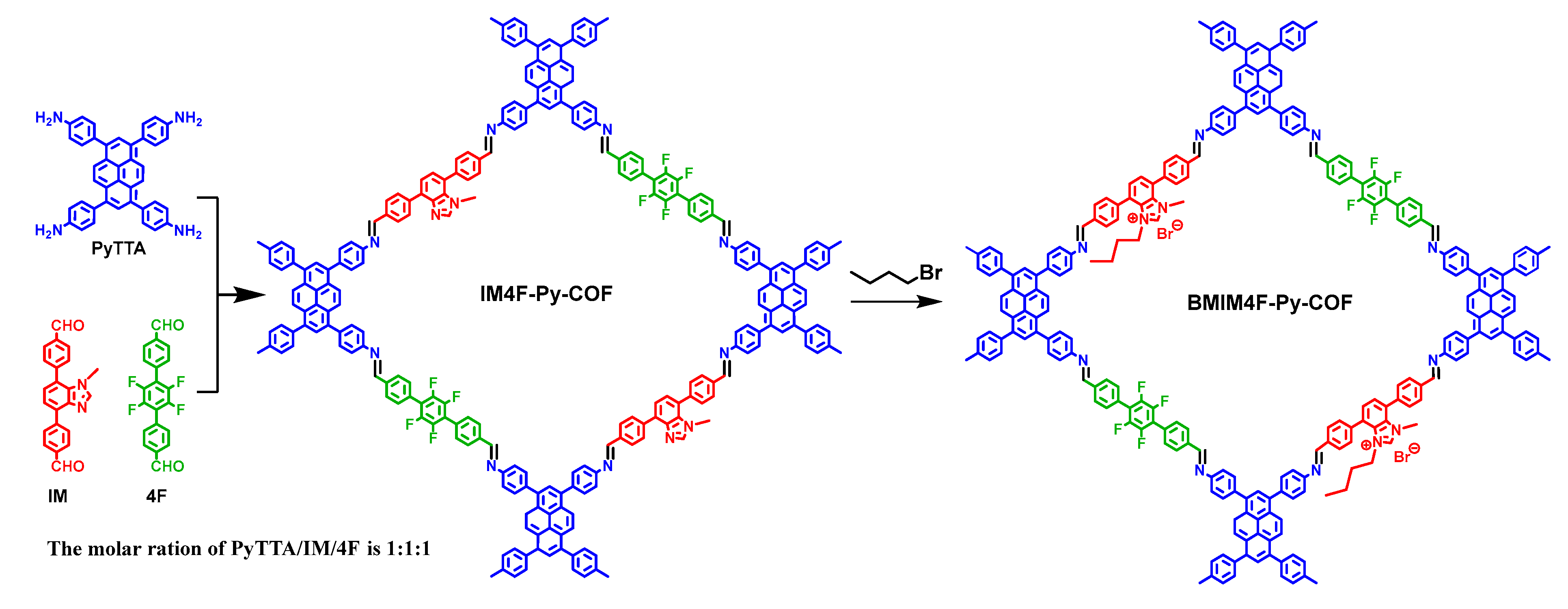
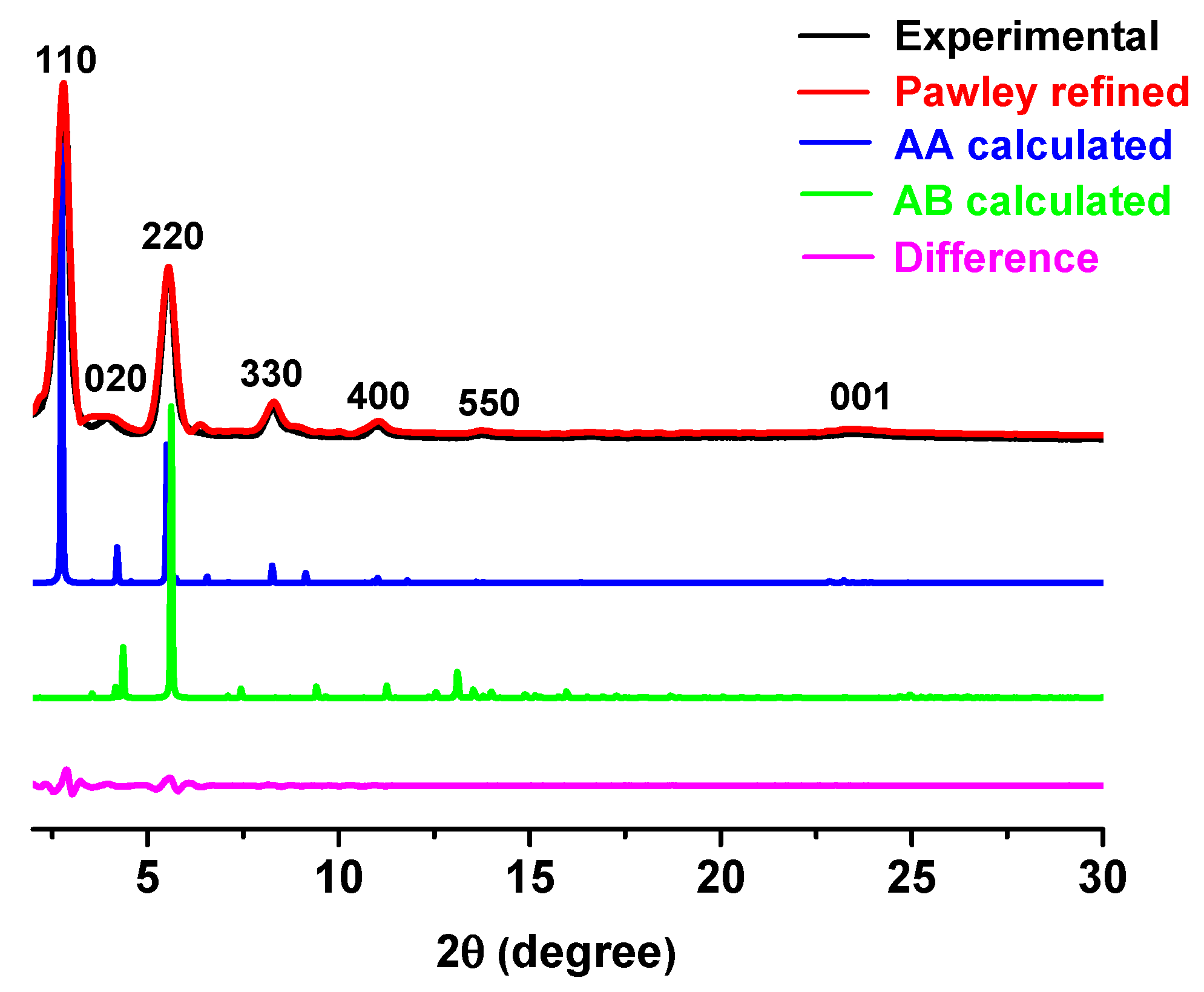
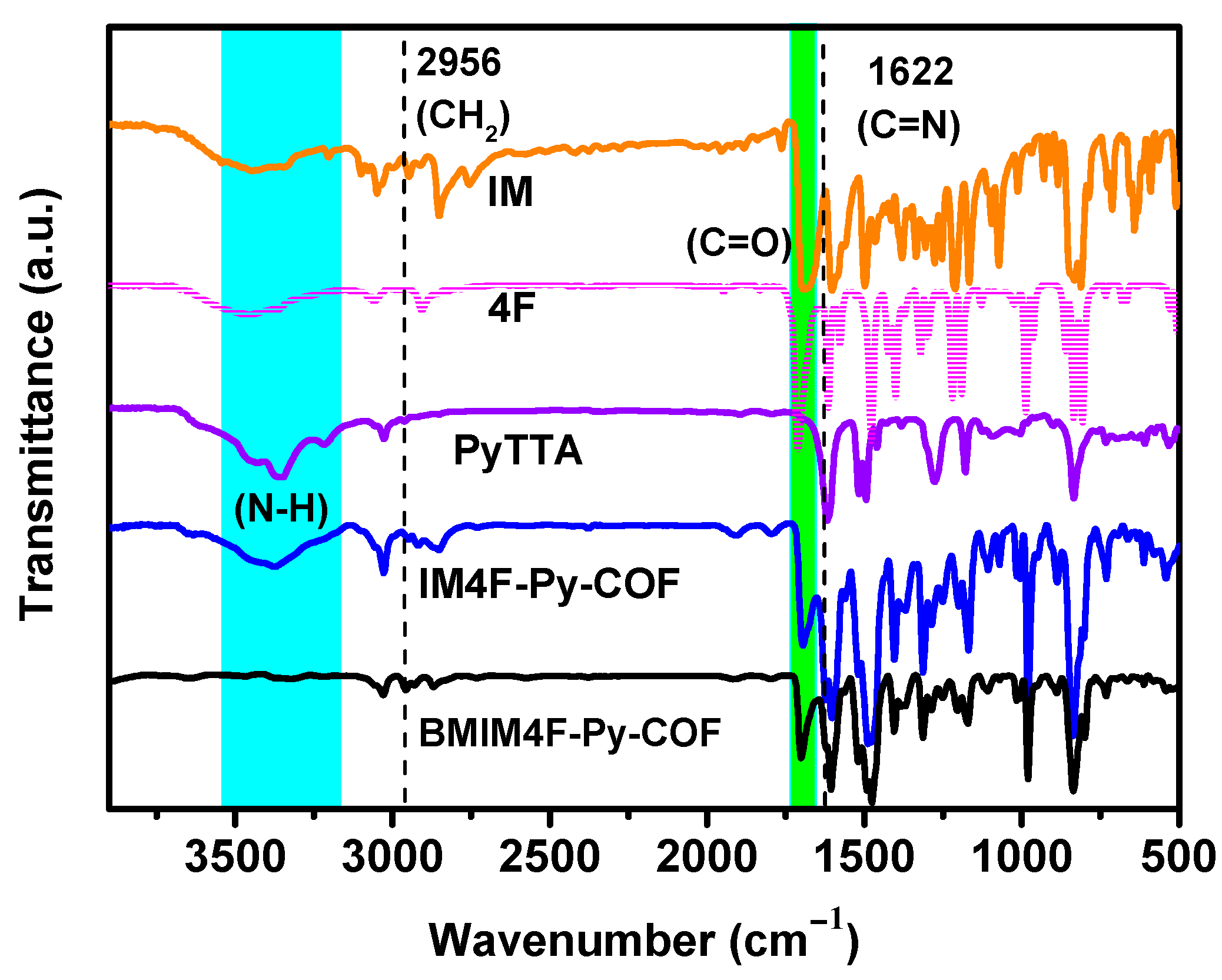
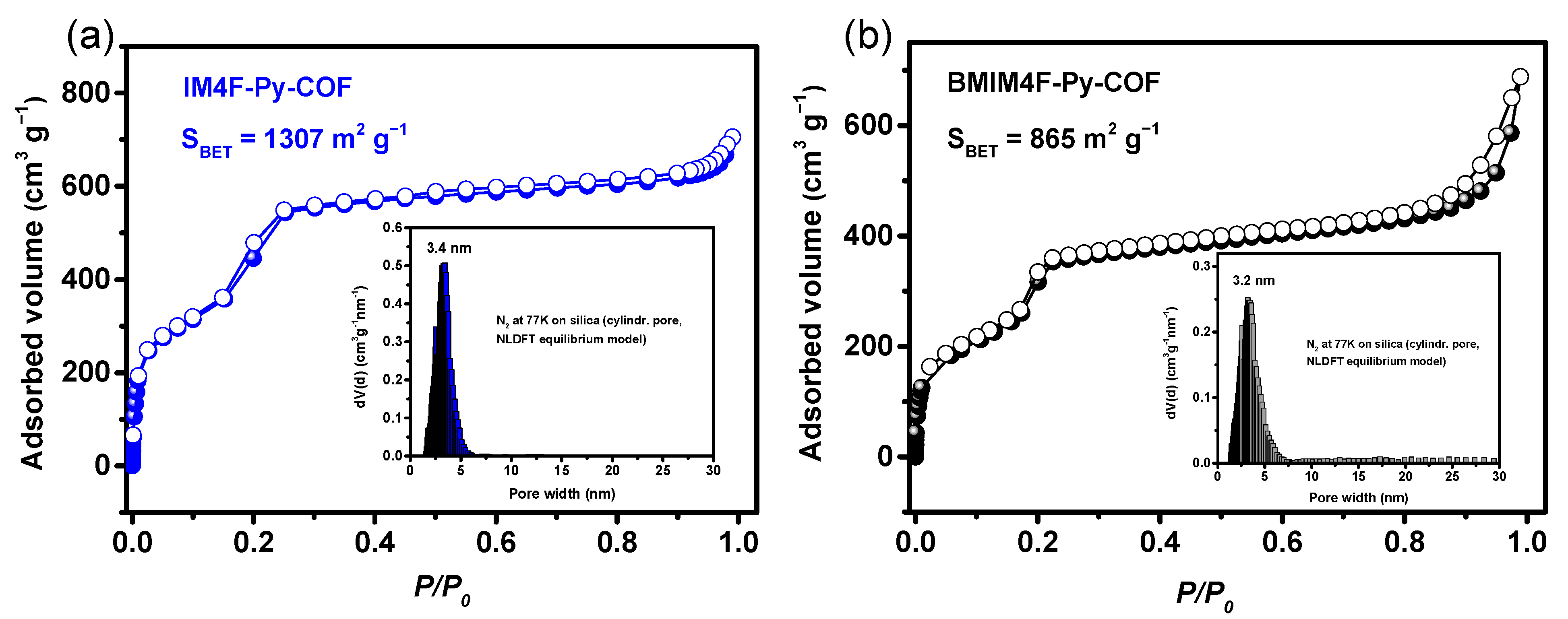
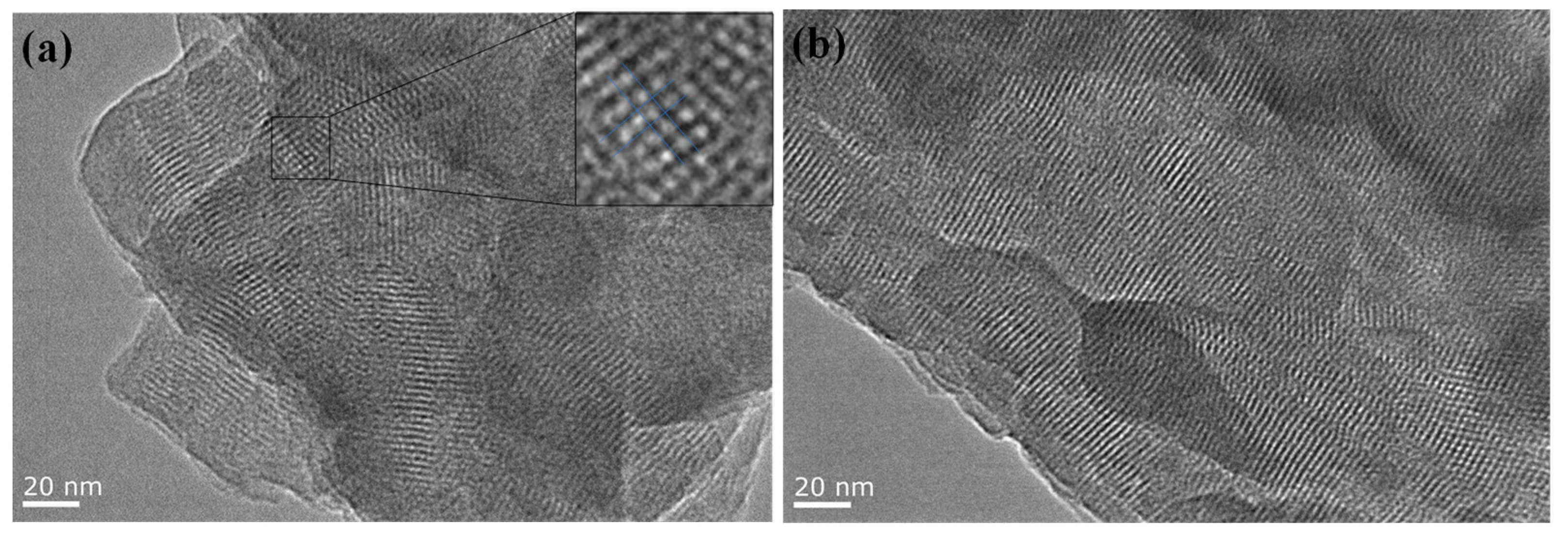
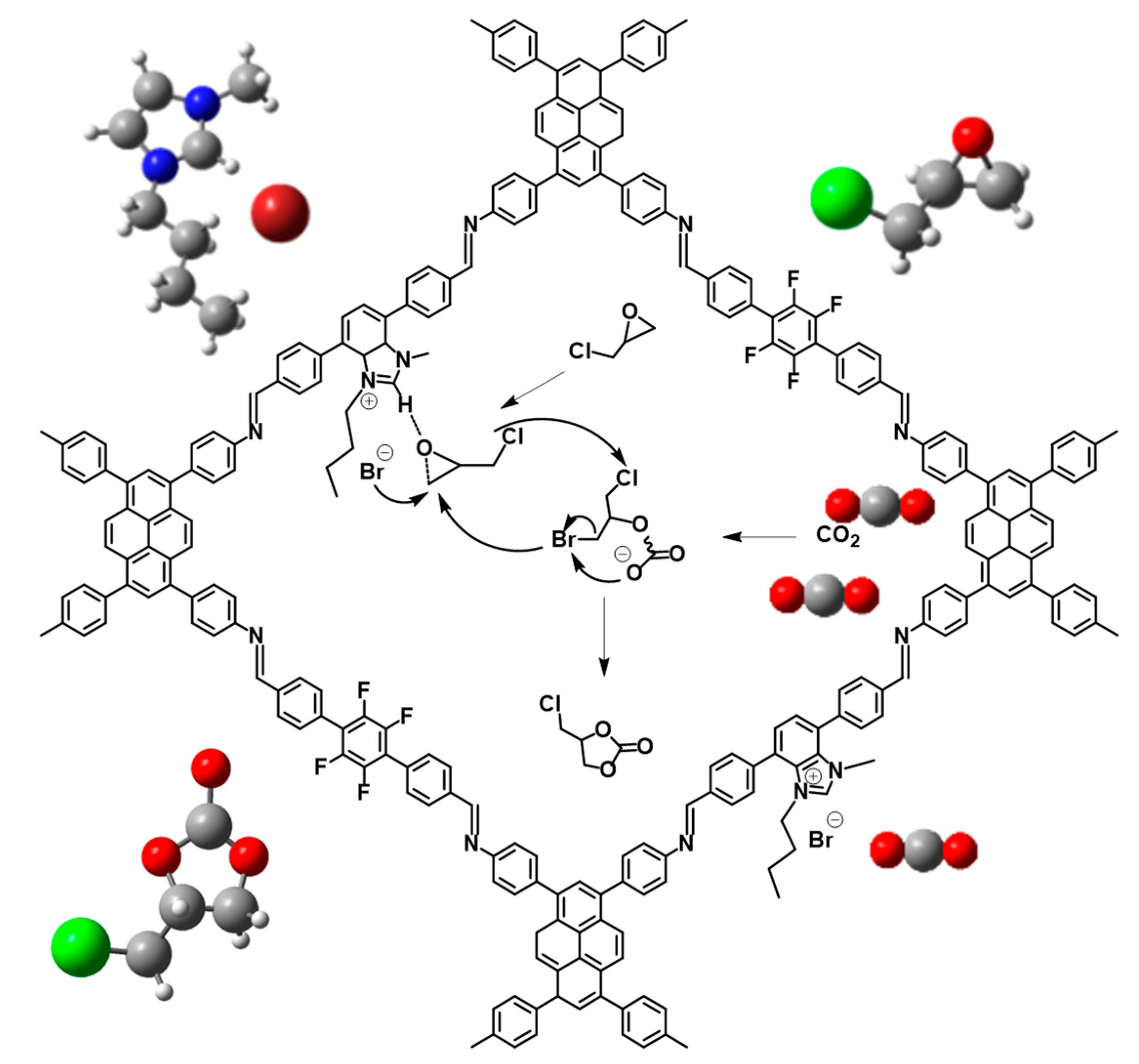
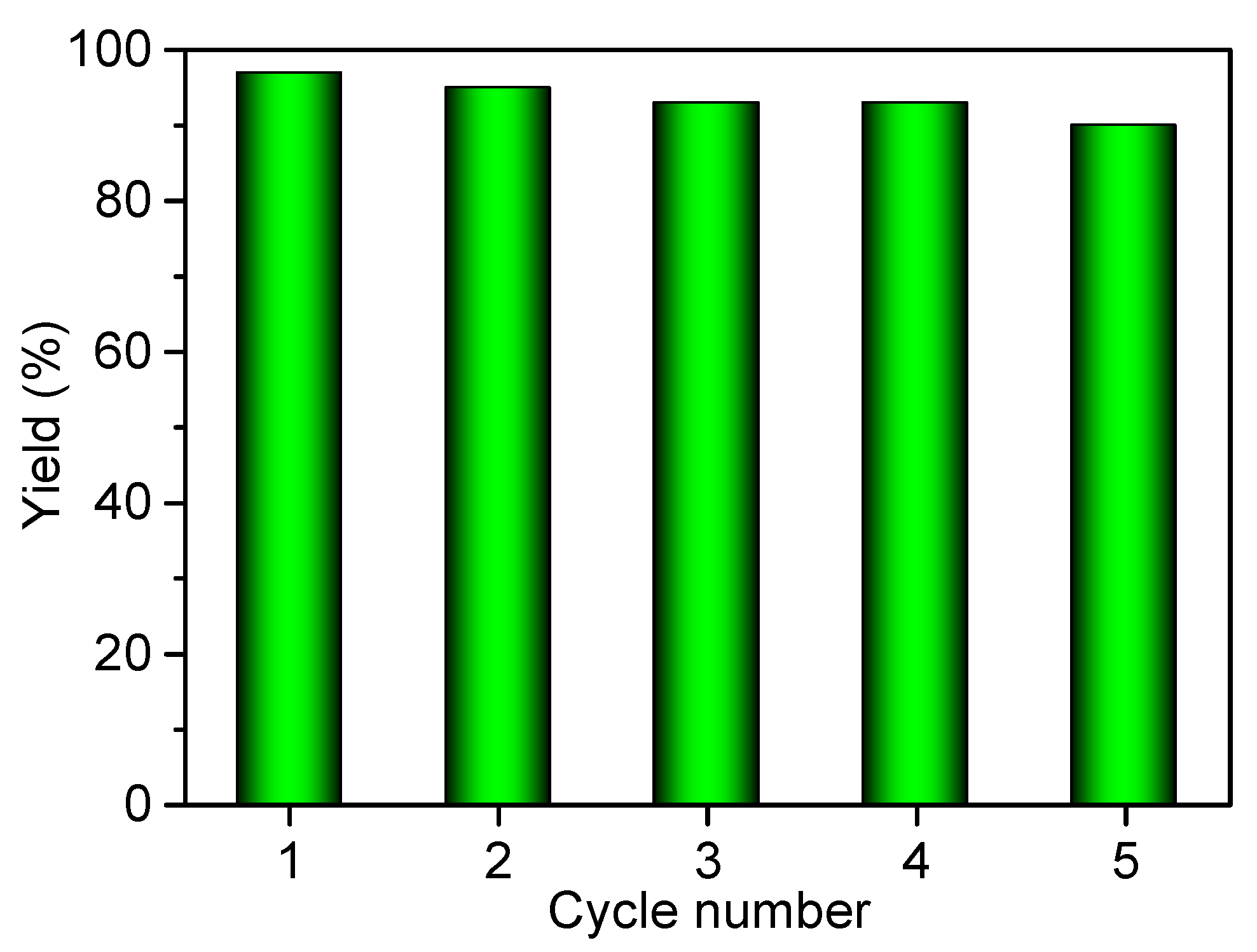
 | |||||||
| Entry | Substrate | Catalyst | Pressure | Temperature | Time | Yield b | TON c |
|---|---|---|---|---|---|---|---|
| (MPa) | (°C) | (h) | (%) | ||||
| 1 |  | BMIM4F-Py-COF | 4.0 | 110 | 12 | 97 | 589 |
| 2 d |  | BMIM4F-Py-COF | 4.0 | 110 | 12 | 88 | 1068 |
| 3 |  | BMIM4F-Py-COF | 4.0 | 120 | 24 | 99 | 601 |
| 4 |  | BMIM4F-Py-COF | 3.0 | 120 | 24 | 99 | 601 |
| 5 |  | BMIM4F-Py-COF | 2.0 | 120 | 24 | 97 | 589 |
| 6 |  | BMIM4F-Py-COF | 1.0 | 120 | 24 | 94 | 571 |
| 7 |  | BMIM4F-Py-COF | 1.0 | 120 | 12 | 91 | 553 |
| 8 |  | BMIM4F-Py-COF | 4.0 | 90 | 12 | 49 | 298 |
| 9 |  | BMIM4F-Py-COF | 3.0 | 110 | 12 | 77 | 467 |
| 10 |  | BMIM4F-Py-COF | 4.0 | 110 | 10 | 94 | 571 |
| 11 |  | BMIM4F-Py-COF | 4.0 | 110 | 8 | 92 | 558 |
| 12 |  | BMIM4F-Py-COF | 4.0 | 110 | 6 | 87 | 528 |
| 13 |  | IM4F-Py-COF | 4.0 | 110 | 12 | 25 | 152 |
 | |||||||
| Entry | Substrate | Catalyst | Pressure | Temperature | Time | Yield b | TON c |
|---|---|---|---|---|---|---|---|
| (MPa) | (°C) | (h) | (%) | ||||
| 1 |  | BMIM4F-Py-COF | 4.0 | 110 | 12 | 100 | 608 |
| 2 |  | BMIM4F-Py-COF | 4.0 | 110 | 12 | 97 | 589 |
| 3 |  | BMIM4F-Py-COF | 4.0 | 90 | 12 | 97 | 589 |
| 4 |  | BMIM4F-Py-COF | 4.0 | 110 | 12 | 87 | 529 |
| 5 |  | BMIM4F-Py-COF | 4.0 | 110 | 12 | 85 | 517 |
| 6 |  | BMIM4F-Py-COF | 4.0 | 110 | 12 | 88 | 535 |
| 7 |  | BMIM4F-Py-COF | 4.0 | 110 | 12 | 80 | 486 |
Publisher’s Note: MDPI stays neutral with regard to jurisdictional claims in published maps and institutional affiliations. |
© 2022 by the authors. Licensee MDPI, Basel, Switzerland. This article is an open access article distributed under the terms and conditions of the Creative Commons Attribution (CC BY) license (https://creativecommons.org/licenses/by/4.0/).
Share and Cite
Yan, Q.; Liang, H.; Wang, S.; Hu, H.; Su, X.; Xiao, S.; Xu, H.; Jing, X.; Lu, F.; Gao, Y. Immobilization of Ionic Liquid on a Covalent Organic Framework for Effectively Catalyzing Cycloaddition of CO2 to Epoxides. Molecules 2022, 27, 6204. https://doi.org/10.3390/molecules27196204
Yan Q, Liang H, Wang S, Hu H, Su X, Xiao S, Xu H, Jing X, Lu F, Gao Y. Immobilization of Ionic Liquid on a Covalent Organic Framework for Effectively Catalyzing Cycloaddition of CO2 to Epoxides. Molecules. 2022; 27(19):6204. https://doi.org/10.3390/molecules27196204
Chicago/Turabian StyleYan, Qianqian, Hao Liang, Shenglin Wang, Hui Hu, Xiaofang Su, Songtao Xiao, Huanjun Xu, Xuechao Jing, Fei Lu, and Yanan Gao. 2022. "Immobilization of Ionic Liquid on a Covalent Organic Framework for Effectively Catalyzing Cycloaddition of CO2 to Epoxides" Molecules 27, no. 19: 6204. https://doi.org/10.3390/molecules27196204
APA StyleYan, Q., Liang, H., Wang, S., Hu, H., Su, X., Xiao, S., Xu, H., Jing, X., Lu, F., & Gao, Y. (2022). Immobilization of Ionic Liquid on a Covalent Organic Framework for Effectively Catalyzing Cycloaddition of CO2 to Epoxides. Molecules, 27(19), 6204. https://doi.org/10.3390/molecules27196204







